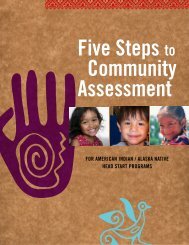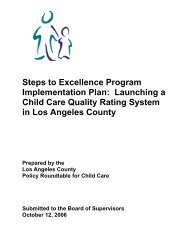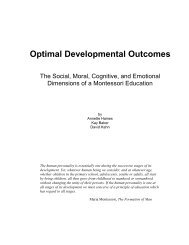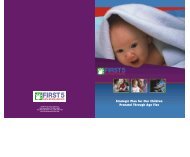OR Head Start - Fight Crime: Invest in Kids
OR Head Start - Fight Crime: Invest in Kids
OR Head Start - Fight Crime: Invest in Kids
Create successful ePaper yourself
Turn your PDF publications into a flip-book with our unique Google optimized e-Paper software.
<strong>Head</strong> <strong>Start</strong> Cuts <strong>Crime</strong> In OregonA Report from FIGHT CRIME: INVEST IN KIDS <strong>OR</strong>EGON
ACKNOWLEDGEMENTSFIGHT CRIME: INVEST IN KIDS <strong>OR</strong>EGON is part of FIGHT CRIME: INVEST IN KIDS,anational, bipartisan, nonprofit, anti-crime organization. The national organizationhas a membership of more than 2,500 police chiefs, sheriffs, prosecutors,other law enforcement leaders and violence survivors. The memberstake a hard-nosed look at what works –– and what doesn’t work –– to preventcrime and violence. They then recommend effective strategies to stateand national policy-makers.FIGHT CRIME: INVEST IN KIDS is supported by tax-deductible contributionsfrom foundations, <strong>in</strong>dividuals, and corporations. FIGHT CRIME: INVEST IN KIDSreceives no funds from federal, state, or local governments.Report authored by Stephanie Schaefer, Ph.D., David Kass, Martha Brooks,and Jeff Kirsch.The follow<strong>in</strong>g staff members of FIGHT CRIME: INVEST IN KIDS contributed toproduction of this report: William Christeson, Michael Kharfen, MichaelRaia, Miriam Roll<strong>in</strong>, and L<strong>in</strong>dsay Warner.Publication design by Elizabeth Kuehl.Copyright © All Rights Reserved 2006, FIGHT CRIME: INVEST IN KIDS <strong>OR</strong>EGON • Beaverton, <strong>OR</strong>FIGHT CRIME: INVEST IN KIDS <strong>OR</strong>EGON • 17675 SW Farm<strong>in</strong>gton Road PMB# 336 • Beaverton, <strong>OR</strong> 97007 • 503.649.2068 • Fax: 503.649.2743
Executive SummaryThe law enforcement members of FIGHT CRIME: INVEST IN KIDS are determ<strong>in</strong>ed to put dangerouscrim<strong>in</strong>als beh<strong>in</strong>d bars. But those on the front l<strong>in</strong>es know that lock<strong>in</strong>g up crim<strong>in</strong>als is not enoughto w<strong>in</strong> the fight aga<strong>in</strong>st crime. Law enforcement leaders recognize that among the most powerfulweapons to prevent crime and violence are quality pre-k<strong>in</strong>dergarten programs, like <strong>Head</strong> <strong>Start</strong>,that help kids get the right start <strong>in</strong> life. <strong>Head</strong> <strong>Start</strong> is a comprehensive early childhooddevelopment program for low-<strong>in</strong>come 3- and 4-year-old children and their families provid<strong>in</strong>g<strong>in</strong>tegrated services <strong>in</strong> preschool education, child health, nutrition, social and emotionaldevelopment, parent education, and family <strong>in</strong>volvement.Research shows that <strong>Head</strong> <strong>Start</strong> and similar pre-k<strong>in</strong>dergarten programs cut crime. Children leftout of <strong>Head</strong> <strong>Start</strong> are more likely to commit crimes when they grow up compared to childrenattend<strong>in</strong>g other preschool programs. The research shows that <strong>Head</strong> <strong>Start</strong> helps kids learn to getalong with others and follow directions, and reduces problem behavior that can lead to youth andadult crime. <strong>Head</strong> <strong>Start</strong> has also shown strong results for children <strong>in</strong> improv<strong>in</strong>g language andmath skills, reduc<strong>in</strong>g grade retention, and <strong>in</strong>creas<strong>in</strong>g graduation rates. This school success has led<strong>Head</strong> <strong>Start</strong> graduates to have higher rates of employment and earn<strong>in</strong>gs. Over 40 years, <strong>Head</strong><strong>Start</strong> has given a literal “head start”to more than 20 million of the country’s most needy children,help<strong>in</strong>g them to become contribut<strong>in</strong>g, responsible adults.But many of Oregon’s children eligible for <strong>Head</strong> <strong>Start</strong> do not receive it. Last year, 40 percent ofOregon’s children eligible for <strong>Head</strong> <strong>Start</strong> were not served by the program, an estimated 6,400children. These children not receiv<strong>in</strong>g <strong>Head</strong> <strong>Start</strong>’s benefits are at greater risk for futurecrim<strong>in</strong>ality. But children receiv<strong>in</strong>g high-quality early childhood programs like <strong>Head</strong> <strong>Start</strong> are asmuch as one-third less likely to go on to commit crimes. Provid<strong>in</strong>g high-quality <strong>Head</strong> <strong>Start</strong>services to all eligible children <strong>in</strong> Oregon can prevent as many as 500 children each year frombecom<strong>in</strong>g future crim<strong>in</strong>als. That’s why the 126 police chiefs, sheriffs, district attorneys, andviolence survivors who are members of FIGHT CRIME: INVEST IN KIDS <strong>OR</strong>EGON, and the more than2,500 members nationally, are committed to provid<strong>in</strong>g <strong>Head</strong> <strong>Start</strong> to all eligible children <strong>in</strong>Oregon and improv<strong>in</strong>g the already high-quality program even further by <strong>in</strong>creas<strong>in</strong>g teacherqualifications and compensation.<strong>Head</strong> <strong>Start</strong> Cuts <strong>Crime</strong> <strong>in</strong> Oregon1
<strong>Head</strong> <strong>Start</strong> Cuts <strong>Crime</strong> In OregonIntroduction<strong>Head</strong> <strong>Start</strong> reduces later crime through a highqualityearly education and child developmentprogram for low-<strong>in</strong>come 3- and 4-year-olds.Children <strong>in</strong> <strong>Head</strong> <strong>Start</strong> programs receivecomprehensive services, such as high-qualitypreschool education, health, nutrition, socialand emotional development components, andparental <strong>in</strong>volvement. <strong>Head</strong> <strong>Start</strong> uses NationalPerformance Standards to ensure a qualityprogram for each child <strong>in</strong> Oregon andthroughout the nation. A nationallyrepresentative study found that the averagequality of <strong>Head</strong> <strong>Start</strong> programs is higher thanthat of other early care and educationprograms. 1Research Shows That <strong>Head</strong> <strong>Start</strong> AndOther Quality Early EducationPrograms Cut <strong>Crime</strong>Research proves what law enforcementprofessionals have learned from experience.Studies show that at-risk kids who attend<strong>Head</strong> <strong>Start</strong> and other high quality prek<strong>in</strong>dergartenprograms are less likely tocommit crimes as adults than similar childrenwho do not attend pre-k<strong>in</strong>dergarten.<strong>Head</strong> <strong>Start</strong>: Research shows that adults whoattended <strong>Head</strong> <strong>Start</strong> as children are less likelyto commit crimes than adults from similarbackgrounds who did not attend <strong>Head</strong> <strong>Start</strong>. Alarge national survey of <strong>Head</strong> <strong>Start</strong> graduatesfound that graduates were 8.5 percent lesslikely to be later arrested or charged with acrime than their sibl<strong>in</strong>gs who attended otherpreschool programs. 2Evidence from Other High-Quality PreschoolProgramsHigh/Scope Perry Preschool: The High/ScopeEducational Research Foundation <strong>in</strong>itiated <strong>in</strong>1962 a random-assignment study of the PerryPreschool Program <strong>in</strong> Ypsilanti, MI. The PerryPreschool Program was a high quality, one- totwo-year long early educational program withan <strong>in</strong>-home parent coach<strong>in</strong>g component. Theresearchers found lifetime crime preventioneffects of the Perry Preschool Program:• By age 27, the at-risk childrenexcluded from the program were fivetimes more likely to grow up to bechronic lawbreakers than those whoattended. 3• At age 40, those who did not attendthe Perry Preschool Program were twiceas likely to be arrested for violent crimesthan those who attended. 4• Those who did not attend the PerryPreschool Program were also more likelyto abuse illegal drugs. Children left outof the program were four times more2 FIGHT CRIME: INVEST IN KIDS <strong>OR</strong>EGON
Quality Pre-K<strong>in</strong>dergartenCuts Future <strong>Crime</strong>At-risk 3 & 4-year-olds randomly excluded from theHigh/Scope Perry Preschool program were fivetimes more likely to become chronic offenders(more than 4 arrests) by age 27.Chronic lawbreakersat age 277%Those who attendedthe preschoolprogramlikely to be arrested for drug felonies,and seven times more likely to bearrested for dangerous drugs than those<strong>in</strong> the program. 5Chicago Child-Parent Centers: Chicago’sfederally-funded Child-Parent Centers haveserved 100,000 three- and 4-year-olds s<strong>in</strong>ce1967. The program is a center-based early<strong>in</strong>tervention program that provides educationaland family-support services to economicallydisadvantaged children.A study compar<strong>in</strong>g 989 children <strong>in</strong> the Child-Parent Centers to 550 similar children whowere not <strong>in</strong> the program showed that childrenwho did not participate <strong>in</strong> the program were 70percent more likely to be arrested for a violentcrime by age 18. 6 This program will haveprevented an estimated 33,000 crimes by thetime the children who have attended theprogram reach the age of 18. 7Furthermore, the Chicago Child-Parent Centerscut the abuse and neglect of children <strong>in</strong> the<strong>Head</strong> <strong>Start</strong> Cuts <strong>Crime</strong> <strong>in</strong> Oregon35%Those who did notattend the preschoolprogramSchwe<strong>in</strong>hart, et al, 1993program <strong>in</strong> half. 8 The reduction of abuse andneglect is significant <strong>in</strong> itself, but it is alsocompell<strong>in</strong>g because of the potential impact onfuture crim<strong>in</strong>al behavior. Studies show thatchildren who were abused or neglected aremore likely to be arrested as juveniles, and tocommit crimes as adults, than children whowere not abused or neglected. 9The research is clear: high quality prek<strong>in</strong>dergartenprograms like <strong>Head</strong> <strong>Start</strong> reducecrime and drug abuse. Cutt<strong>in</strong>g crime <strong>in</strong> Oregonis important to the social and economic wellbe<strong>in</strong>gof the state and its citizens. Accord<strong>in</strong>g tothe U.S. Department of Justice, 180,750 crimeswere committed <strong>in</strong> Oregon <strong>in</strong> 2003, <strong>in</strong>clud<strong>in</strong>g10,520 violent crimes 10 .<strong>Crime</strong> <strong>in</strong> Oregon 1110,520 violent crimes68 murders or nonnegligent manslaughters1218 rapes2851 robberies6,383 assaults170,230 property crimes28,626 burglaries122,615 larceny –theft18,989 motor vehicle theftTotal: 180,750 crimes committed <strong>in</strong> Oregon <strong>in</strong> 2003Over 30,000 juveniles are arrested every year <strong>in</strong>Oregon. 12 Despite the best efforts of lawenforcement, these crimes will cont<strong>in</strong>ue to becommitted unless serious measures are takenbefore – not only after – crimes occur. The<strong>Head</strong> <strong>Start</strong> program prevents crime by help<strong>in</strong>gkids get the right start <strong>in</strong> life.<strong>Head</strong> <strong>Start</strong> Helps Children SucceedIn addition to crime prevention, <strong>Head</strong> <strong>Start</strong>also helps children succeed <strong>in</strong> school. Everyday, k<strong>in</strong>dergarten teachers witness thedifference between children who receivedhigh-quality pre-k<strong>in</strong>dergarten and those who3
did not. Accord<strong>in</strong>g to a national poll ofk<strong>in</strong>dergarten teachers conducted by Mason-Dixon Poll<strong>in</strong>g for FIGHT CRIME: INVEST IN KIDS,n<strong>in</strong>e out of 10 teachers reported that childrenwho attended pre-k<strong>in</strong>dergarten programs arebetter prepared to succeed <strong>in</strong> school than thosewho did not. 13Decades of research also confirm that highquality pre-k<strong>in</strong>dergarten programs have longtermeducational and economic effects. Astudy with a nationally representative sampleof 2,800 children showed that <strong>Head</strong> <strong>Start</strong>significantly raised average scores of children’sperformance. Moreover, the largest ga<strong>in</strong>s weremade by the lower-perform<strong>in</strong>g children,especially <strong>in</strong> the areas of vocabulary and earlywrit<strong>in</strong>g. The program narrowed the schoolread<strong>in</strong>ess gap between children from low<strong>in</strong>comehomes who attended <strong>Head</strong> <strong>Start</strong> andchildren from higher-<strong>in</strong>come homes. Testresults also showed that <strong>Head</strong> <strong>Start</strong> graduatescont<strong>in</strong>ued to outpace other similar children <strong>in</strong>their learn<strong>in</strong>g dur<strong>in</strong>g k<strong>in</strong>dergarten, therebyfurther narrow<strong>in</strong>g the performance gap. 14 Aseparate new national study, utiliz<strong>in</strong>g the bestdesign possible – a randomized controltrial – found that,“<strong>Head</strong> <strong>Start</strong> reduced, byalmost half, the achievement gap <strong>in</strong> preread<strong>in</strong>gskills between <strong>Head</strong> <strong>Start</strong> children andthe national average for all 3- and 4-yearolds.” 15 In another large national survey,researchers found that former <strong>Head</strong> <strong>Start</strong>students were more likely to graduate fromhigh school and to attend college than theirsibl<strong>in</strong>gs who attended other preschools. 16In addition to these important ga<strong>in</strong>s <strong>in</strong> schoolperformance, <strong>Head</strong> <strong>Start</strong> also promoteschildren’s health and can reduce mortality fromchronic childhood illnesses. One recentanalysis exam<strong>in</strong>ed data from <strong>Head</strong> <strong>Start</strong>’sbeg<strong>in</strong>n<strong>in</strong>g years when the program was be<strong>in</strong>gphased <strong>in</strong>. It found that <strong>Head</strong> <strong>Start</strong>’s healthservices and health screen<strong>in</strong>g led to a 33percent to 75 percent decl<strong>in</strong>e <strong>in</strong> mortality ratesfor children at ages five to n<strong>in</strong>e compared tosimilar children <strong>in</strong> other counties with less or<strong>Head</strong> <strong>Start</strong> Narrows the Gap between ItsYoungsters and Other American ChildrenPercentile rank<strong>in</strong>g for vocabulary scores of<strong>Head</strong> <strong>Start</strong> children*14thBeg<strong>in</strong>n<strong>in</strong>g of<strong>Head</strong> <strong>Start</strong>21stEnd of<strong>Head</strong> <strong>Start</strong>no <strong>Head</strong> <strong>Start</strong> fund<strong>in</strong>g. 1732ndEnd ofk<strong>in</strong>dergarten*A 14th percentile rank means that <strong>Head</strong> <strong>Start</strong> children scoredabove 14% of American children (of the same age).Like <strong>Head</strong> <strong>Start</strong>, Early <strong>Head</strong> <strong>Start</strong> also helpslow-<strong>in</strong>come children prepare for future schoolsuccess. Early <strong>Head</strong> <strong>Start</strong> was created <strong>in</strong> 1994to provide comprehensive child developmentand family strengthen<strong>in</strong>g services to babies andtoddlers from birth to age three. A largeevaluation study of Early <strong>Head</strong> <strong>Start</strong> found thatfamilies randomly assigned to receive thecomb<strong>in</strong>ed center/<strong>in</strong>-home parent coach<strong>in</strong>gapproach were 62 percent more likely to readto their children daily than families who didnot receive the program. Children left out ofthe comb<strong>in</strong>ed Early <strong>Head</strong> <strong>Start</strong> approach were34 percent more likely to score <strong>in</strong> the low rangeon a test of cognitive, social and emotionaldevelopment than those enrolled <strong>in</strong> theprogram. 18The success of <strong>Head</strong> <strong>Start</strong> carries over <strong>in</strong>to highschool. Lead<strong>in</strong>g experts <strong>in</strong> the field of earlyeducation, like Dr. W. Steven Barnett of theNational Institute for Early Education Research(NIEER), have critically reviewed <strong>Head</strong> <strong>Start</strong>studies and determ<strong>in</strong>ed that the positive effects4 FIGHT CRIME: INVEST IN KIDS <strong>OR</strong>EGON
for <strong>Head</strong> <strong>Start</strong> teachers, plus additionalexpenses to help pay the costs of teachersgett<strong>in</strong>g their college degrees. 28 The Center forLaw and Social Policy estimates that the costsof <strong>in</strong>creas<strong>in</strong>g <strong>Head</strong> <strong>Start</strong> teacher education andcompensation nationally as called for <strong>in</strong> currentfederal reauthorization proposals will beapproximately $2.7 billion to $3.4 billion oversix years. 29Oregon <strong>Head</strong> <strong>Start</strong> Prek<strong>in</strong>dergartenS<strong>in</strong>ce 1988, <strong>Head</strong> <strong>Start</strong> services <strong>in</strong> Oregon havebeen funded by both the federal <strong>Head</strong> <strong>Start</strong>program and state dollars. Oregon <strong>Head</strong> <strong>Start</strong>Prek<strong>in</strong>dergarten comb<strong>in</strong>es state and federalfund<strong>in</strong>g <strong>in</strong>to one seamless program, andrequires the same rigorous federal <strong>Head</strong> <strong>Start</strong>Performance Standards that help ensure qualityservices for children and families. Oregon<strong>Head</strong> <strong>Start</strong> uses the federal eligibilityrequirements, requir<strong>in</strong>g 90 percent of childrenserved to have family <strong>in</strong>comes at or below thefederal poverty guidel<strong>in</strong>es, $16,090 for a familyof three. 30 Oregon modifies this requirementslightly for state-funded <strong>Head</strong> <strong>Start</strong> children,allow<strong>in</strong>g as many as 20 percent of childrenenrolled to have family <strong>in</strong>comes above thefederal poverty guidel<strong>in</strong>es. In addition to<strong>in</strong>come, local programs use locally developedpriority rat<strong>in</strong>g systems that <strong>in</strong>clude other familyrisk factors beyond <strong>in</strong>come level (such asreferrals from pediatricians, referrals for parentalcohol and drug addiction, and child abuseand neglect) to determ<strong>in</strong>e enrollment prioritiesamong eligible children.From 2003 to 2005, Oregon <strong>in</strong>vested$53,582,328 <strong>in</strong> state dollars for <strong>Head</strong> <strong>Start</strong> <strong>in</strong>addition to the federal <strong>Head</strong> <strong>Start</strong> programfunds of $99 million to serve Oregon’s needychildren over the two-year period, total<strong>in</strong>g$152,582,328. 31Between 2003 and 2005, Oregon <strong>Head</strong> <strong>Start</strong>Prek<strong>in</strong>dergarten served 19,094 children <strong>in</strong> 658classrooms <strong>in</strong> all 36 counties. The programserves children from a variety of racial andethnic backgrounds, reflect<strong>in</strong>g statedemographic characteristics. In the 2003-2004school year, 48 percent of enrolled childrenwere white, 31 percent were Lat<strong>in</strong>o, sevenpercent were African-American, seven percentwere biracial or multiracial, two percent wereAmerican Indian or Alaska Native, and twopercent were Asian. 32 Seventy-one percent ofchildren <strong>in</strong> Oregon <strong>Head</strong> <strong>Start</strong> Prek<strong>in</strong>dergartenspeak English as their dom<strong>in</strong>ant language, 24percent speak Spanish, two percent speakAsian languages, and two percent speak otherlanguages as their dom<strong>in</strong>ant language. 33About three-fourths (74 percent) of Oregon<strong>Head</strong> <strong>Start</strong> Prek<strong>in</strong>dergarten families areemployed full-time or part-time, and another15 percent participate <strong>in</strong> job tra<strong>in</strong><strong>in</strong>g programsor attend school. 34Like <strong>Head</strong> <strong>Start</strong> programs around the country,Oregon <strong>Head</strong> <strong>Start</strong> Prek<strong>in</strong>dergarten specializes <strong>in</strong>serv<strong>in</strong>g children with disabilities. Federal andstate program rules require that at least 10percent of the total enrollment be reserved forchildren with disabilities. Oregon exceeds thisrequirement and dedicates approximately 16percent of its enrollment for children withdisabilities. 35Provid<strong>in</strong>g <strong>Head</strong> <strong>Start</strong> programs <strong>in</strong> rural areascan be a challenge due to the low populationdensity and geographic dispersion of familiesthroughout rural areas. Despite these <strong>in</strong>herentchallenges, Oregon <strong>Head</strong> <strong>Start</strong> Prek<strong>in</strong>dergartenprovides <strong>Head</strong> <strong>Start</strong> services <strong>in</strong> ruralcommunities, serv<strong>in</strong>g every county <strong>in</strong> thestate. 36 S<strong>in</strong>ce local programs create their ownbudgets, some programs <strong>in</strong> rural communitiesaddress the geographic dispersion of familiesby devot<strong>in</strong>g more resources to extensivetransportation services to bus children fromoutly<strong>in</strong>g areas to the program.The federally funded Migrant <strong>Head</strong> <strong>Start</strong>program serves communities with largeconcentrations of migrant farm worker families.Accord<strong>in</strong>g to Dell Ford of the Oregon <strong>Head</strong>6 FIGHT CRIME: INVEST IN KIDS <strong>OR</strong>EGON
<strong>Start</strong> Collaboration Office, there is one Migrant<strong>Head</strong> <strong>Start</strong> grantee <strong>in</strong> Oregon, the OregonChild Development Coalition (OCDC), whichoperates 11 program sites across the state.OCDC provides services to 2,469 childrenrang<strong>in</strong>g <strong>in</strong> age from birth to five. The Migrant<strong>Head</strong> <strong>Start</strong> program [or OCDC?] also operatestwo state-funded <strong>Head</strong> <strong>Start</strong> programs forchildren who meet the general <strong>Head</strong> <strong>Start</strong>eligibility criteria. 37The federally funded Tribal <strong>Head</strong> <strong>Start</strong> programserves American Indian children. There aren<strong>in</strong>e recognized tribes <strong>in</strong> Oregon, five of whichhave federal <strong>Head</strong> <strong>Start</strong> fund<strong>in</strong>g and provideservices to 304 children. Additionally, theGrande Ronde Tribe allocates their tribal fundsto serve an additional 27 children. 38Despite <strong>Head</strong> <strong>Start</strong>’s Benefits, 40Percent of Eligible Children <strong>in</strong> Oregonare Not ServedDespite the school success and crimeprevention benefits of <strong>Head</strong> <strong>Start</strong> for at-riskchildren, only 60 percent of eligible children <strong>in</strong>Oregon participate <strong>in</strong> the program. Last year,approximately 9,600 of Oregon’s children wereserved by <strong>Head</strong> <strong>Start</strong> programs. 39 Of theestimated 16,000 children eligible for <strong>Head</strong><strong>Start</strong>, 6,400 children—or 40 percent—did notreceive the program <strong>in</strong> 2005 due to lack ofOregon <strong>Head</strong> <strong>Start</strong> Prek<strong>in</strong>dergarten Servicesand Unmet Need <strong>in</strong> 2005Children Eligible(estimate)Children Served(federal and state funded)Eligible Children NotServedTotal Children(ages 3 and 4)Number Percent16,000 100%9,6006,40060%40%Soiurce: Oregon Department of Education, 2005.fund<strong>in</strong>g. 40State agency officials report that local <strong>Head</strong><strong>Start</strong> programs are at full capacity, andprograms have wait<strong>in</strong>g lists <strong>in</strong> all but one ofthe communities served. For example, <strong>in</strong> eastMultnomah County, the Mt. Hood CommunityCollege <strong>Head</strong> <strong>Start</strong> Prek<strong>in</strong>dergarten programhas over 300 eligible children on the wait<strong>in</strong>glist to receive <strong>Head</strong> <strong>Start</strong>. 41 Accord<strong>in</strong>g toOregon state government agency officials,there is a demand for additional <strong>Head</strong> <strong>Start</strong>services. If Oregon had additional federal<strong>Head</strong> <strong>Start</strong> or state pre-k<strong>in</strong>dergarten funds,Oregon <strong>Head</strong> <strong>Start</strong> Prek<strong>in</strong>dergarten could servemore children.Recent federal budget cuts put further stress onthe capacity of Oregon <strong>Head</strong> <strong>Start</strong>Prek<strong>in</strong>dergarten to serve eligible needy children.The federal portion of Oregon’s <strong>Head</strong> <strong>Start</strong>program is subject to a one percent budget cut,retroactive to October 2005. Oregon <strong>Head</strong><strong>Start</strong> Prek<strong>in</strong>dergarten agency officials estimatethat to implement this budget cut,approximately 200 children could be cut fromthe program. 42 In the President’s budgetproposal for Fiscal Year 2007, <strong>Head</strong> <strong>Start</strong> willreceive no additional fund<strong>in</strong>g, which will result<strong>in</strong> Oregon serv<strong>in</strong>g even fewer children due to<strong>in</strong>flation. 43Fully Fund<strong>in</strong>g High-Quality <strong>Head</strong><strong>Start</strong> Can Prevent As Many As 500Children Each Year From Becom<strong>in</strong>gFuture Crim<strong>in</strong>als <strong>in</strong> OregonAs described earlier <strong>in</strong> this report, researchshows that high-quality early childhoodeducation programs such as <strong>Head</strong> <strong>Start</strong>can help at-risk children get on tracktowards be<strong>in</strong>g productive citizens andprevent them from becom<strong>in</strong>g futurecrim<strong>in</strong>als. Given this compell<strong>in</strong>g crimeprevention evidence, provid<strong>in</strong>g <strong>Head</strong> <strong>Start</strong>to all eligible children would benefit thecitizens of Oregon by help<strong>in</strong>g thesechildren succeed <strong>in</strong> school and <strong>in</strong> life and<strong>Head</strong> <strong>Start</strong> Cuts <strong>Crime</strong> <strong>in</strong> Oregon7
prevent<strong>in</strong>g future crimes.What is the cost to Oregon <strong>in</strong> future crimes fornot provid<strong>in</strong>g <strong>Head</strong> <strong>Start</strong> for all eligiblechildren?Us<strong>in</strong>g the best research evidence available, wecan estimate the crime prevention potential ofprovid<strong>in</strong>g high-quality <strong>Head</strong> <strong>Start</strong> to all ofOregon’s eligible children currently notreceiv<strong>in</strong>g the program. Most children <strong>in</strong> <strong>Head</strong><strong>Start</strong>, like most children <strong>in</strong> general, do notbecome crim<strong>in</strong>als. However, one study us<strong>in</strong>gnational data and track<strong>in</strong>g children <strong>in</strong>toadulthood shows that approximately one <strong>in</strong> tenof the children with family <strong>in</strong>comes below thefederal poverty guidel<strong>in</strong>es will be charged witha crime later <strong>in</strong> life. 44Approximately 16,000 children <strong>in</strong> Oregon wereeligible for <strong>Head</strong> <strong>Start</strong> <strong>in</strong> 2005. Based on onenational study on the proportion of <strong>Head</strong> <strong>Start</strong>eligible children who go on to be booked orcharged with a crime, we can expect thatapproximately 1,600 of these children – 10percent of the 16,000 children eligible for <strong>Head</strong><strong>Start</strong> — are likely to be charged with a crime. 45The rest will be law-abid<strong>in</strong>g citizens.How much of a difference can <strong>Head</strong> <strong>Start</strong> make<strong>in</strong> prevent<strong>in</strong>g future crime?As described earlier <strong>in</strong> this report, onelongitud<strong>in</strong>al study us<strong>in</strong>g national datademonstrated that children who attended<strong>Head</strong> <strong>Start</strong> were 8.5 percent less likely to becharged with a crime as youth or adults thanwere their sibl<strong>in</strong>gs who did not attend <strong>Head</strong><strong>Start</strong> but attended other preschool programs<strong>in</strong>stead. 46 So even compared to <strong>Head</strong>-<strong>Start</strong>eligiblechildren who attended anotherpreschool program, children who attended<strong>Head</strong> <strong>Start</strong> had a lower rate of future crim<strong>in</strong>albehavior. 47While <strong>Head</strong> <strong>Start</strong>’s 8.5 percent reduction <strong>in</strong>future crim<strong>in</strong>als is a compell<strong>in</strong>gaccomplishment, we have evidence that thehighest-quality early childhood programs canachieve even greater reductions <strong>in</strong> future crime.One such program, the Chicago Child-ParentCenters (CPC), has been shown to cut overallcrime among juveniles by one-third (32.6percent). 48 The Chicago Child-Parent Center isa large-scale early <strong>in</strong>tervention that providescomprehensive educational and family-supportservices to economically disadvantagedchildren. The CPC program is the secondoldestfederally funded preschool program <strong>in</strong>the U.S. and is among the highest quality earlychildhood programs available. For example,every CPC program lead teacher has aBachelor’s degree. With improvements to <strong>Head</strong><strong>Start</strong> program quality, especially <strong>in</strong>creases <strong>in</strong>the number of teachers with four-year degrees,<strong>Head</strong> <strong>Start</strong> could achieve even higher rates ofcrime prevention, similar to the Chicago CPCprogram.Therefore, we can expect that provid<strong>in</strong>g highquality<strong>Head</strong> <strong>Start</strong> to all eligible children <strong>in</strong>Oregon can reduce the number of <strong>Head</strong> <strong>Start</strong>graduates who go on to be crim<strong>in</strong>als by at least8.5 percent and up to as much as one-third.<strong>Head</strong> <strong>Start</strong> could prevent as many as 500 at-riskchildren <strong>in</strong> Oregon from becom<strong>in</strong>g crim<strong>in</strong>alseach year.Because these are rough estimates, we will useballpark numbers to illustrate our po<strong>in</strong>ts. (Seeappendix A for specific numbers).Research shows that 8.5 percent of these 1,600potential crim<strong>in</strong>als <strong>in</strong> Oregon could beprevented from becom<strong>in</strong>g crim<strong>in</strong>als if they allreceived <strong>Head</strong> <strong>Start</strong>. That is approximately 140children prevented from becom<strong>in</strong>g crim<strong>in</strong>alseach year. (About two-thirds of them arealready receiv<strong>in</strong>g <strong>Head</strong> <strong>Start</strong>, so Oregon isalready reap<strong>in</strong>g part of this unrecognizedreduction <strong>in</strong> crime each year.)If <strong>Head</strong> <strong>Start</strong> were improved <strong>in</strong> quality to thelevel of the Chicago Child-Parent Centersprograms – <strong>in</strong>clud<strong>in</strong>g quality improvements <strong>in</strong>8 FIGHT CRIME: INVEST IN KIDS <strong>OR</strong>EGON
pend<strong>in</strong>g reauthorization legislation – aboutone-third (32.6 percent) of those 1,600 childrencould be steered away from crime, orapproximately 500 children each year.Prevent<strong>in</strong>g 500 future crim<strong>in</strong>als is fairlyimpressive; but we should consider that thereductions <strong>in</strong> the number of crim<strong>in</strong>als adds upover time and some crim<strong>in</strong>als are very active:• Prevent<strong>in</strong>g 500 crim<strong>in</strong>als is a per-yearestimate; the reduction <strong>in</strong> futurecrim<strong>in</strong>als from one <strong>Head</strong> <strong>Start</strong> schoolyear will be multiplied many times overfor each graduat<strong>in</strong>g class of childrenprovided the highest-quality <strong>Head</strong> <strong>Start</strong>experience.• Many of those crim<strong>in</strong>als commit onlyone, fairly m<strong>in</strong>or crime. But others go onto commit multiple crimes over theirlifetime, <strong>in</strong>clud<strong>in</strong>g violent felonies.Therefore, a decrease <strong>in</strong> the number offuture crim<strong>in</strong>als will cut an even greaternumber of future crimes.The federal government must <strong>in</strong>crease its<strong>in</strong>vestment <strong>in</strong> Oregon’s high-quality <strong>Head</strong><strong>Start</strong> for all eligible at-risk children. In do<strong>in</strong>gso, Oregon can count on not only improv<strong>in</strong>gthe number of children who succeed <strong>in</strong> schoolbut also mak<strong>in</strong>g a substantial reduction <strong>in</strong> the180,750 total crimes and 10,520 violent crimesthat happen every year <strong>in</strong> the state. 49Law Enforcement Backs <strong>Invest</strong>ment <strong>in</strong>Quality Early Care and EducationProgramsWhen law enforcement leaders nationwidewere surveyed by the <strong>in</strong>dependent poll<strong>in</strong>g firmMason-Dixon Poll<strong>in</strong>g and Research, anoverwhelm<strong>in</strong>g 71 percent chose,“more afterschoolprograms and educational child careprograms”as the most effective strategy forprevent<strong>in</strong>g youth violence and crime. 50 TheOregon Association Chiefs of Police, theOregon State Sheriff’s Association, and the<strong>Head</strong> <strong>Start</strong> Cuts <strong>Crime</strong> <strong>in</strong> OregonOregon District Attorney’s Association haveendorsed <strong>in</strong>vestments <strong>in</strong> quality earlychildhood care and education programs, ashave national law enforcement organizationssuch as the Fraternal Order of Police and theNational District Attorneys Association. 51 It istime to ensure that more children have accessto educational early childhood programs like<strong>Head</strong> <strong>Start</strong> that are proven to save money andcut crime.ConclusionOver 10,000 violent crimes are committed <strong>in</strong>Oregon every year. More than 30,000 juvenilesare arrested <strong>in</strong> Oregon annually. Despite thebest efforts from law enforcement, thesepatterns will cont<strong>in</strong>ue, unless we take seriousmeasures before – not after – such tragediesoccur.It’s time to <strong>in</strong>vest <strong>in</strong> what works to preventcrime. The research evidence is clear: highqualityearly education programs like <strong>Head</strong><strong>Start</strong> are crucial to reduc<strong>in</strong>g crime. And withquality improvements, <strong>Head</strong> <strong>Start</strong> can makeeven more dramatic cuts <strong>in</strong> future crime.Provid<strong>in</strong>g high-quality <strong>Head</strong> <strong>Start</strong> to all eligiblechildren <strong>in</strong> Oregon can prevent as many as 500at-risk children each year from becom<strong>in</strong>gcrim<strong>in</strong>als.That is why the members of FIGHT CRIME:INVEST IN KIDS <strong>OR</strong>EGON are call<strong>in</strong>g on Oregon’selected leaders to ensure that <strong>Head</strong> <strong>Start</strong>services are available to all eligible children andthat program quality is enhanced by <strong>in</strong>creas<strong>in</strong>g<strong>Head</strong> <strong>Start</strong> teacher qualifications and provid<strong>in</strong>g<strong>in</strong>creased compensation to reta<strong>in</strong> highlyqualifiedteachers.9
APPENDIX AEstimate of <strong>Head</strong> <strong>Start</strong>’s <strong>Crime</strong> Reduction PotentialA national study found that 10% of children with family <strong>in</strong>comes below federal poverty guidel<strong>in</strong>es(children eligible for <strong>Head</strong> <strong>Start</strong>) will be charged with a crime. ANumber of 3- and 4-year-old children <strong>in</strong> Oregon eligible for <strong>Head</strong> <strong>Start</strong>: 16,000 B .10% of 16,000 = 1,600 children <strong>in</strong> Oregon eligible for <strong>Head</strong> <strong>Start</strong> will go on to be charged with a crime.Children who attended <strong>Head</strong> <strong>Start</strong> were 8.5% less likely to be charged with a crime as youth oradults than were their sibl<strong>in</strong>gs who did not attend <strong>Head</strong> <strong>Start</strong> but attended other preschool programs<strong>in</strong>stead. CChildren who attended the very high-quality Chicago Child-Parent Centers program were 32.6%less likely to commit crimes as juveniles. D8.5% x 1,600 = 136, or roughly 140 children prevented from becom<strong>in</strong>g crim<strong>in</strong>als per year32.6% x 1,600 = 522, or roughly 500 children prevented from becom<strong>in</strong>g crim<strong>in</strong>als per yearA Garces, E., Thomas, D., & Currie, J. (2002). Longer-term effects of <strong>Head</strong> <strong>Start</strong>. American Economic Review, 92(4), 999-1012.B Oregon Department of Education. (2005, March). Oregon <strong>Head</strong> <strong>Start</strong> Prek<strong>in</strong>dergarten: <strong>Invest</strong><strong>in</strong>g In Oregon’s Future.Report to Oregon’s Seventy-Third Legislative Assembly. Based on estimates of number of children with family <strong>in</strong>comes belowfederal poverty guidel<strong>in</strong>es.C Duncan Thomas, personal communication via e-mail to Cate Miller, Co-Director of Research on February 28, 2003, basedon an analysis of data <strong>in</strong> Garces, E., Thomas, D., & Currie, J. (2002). Longer-term effects of <strong>Head</strong> <strong>Start</strong>. American EconomicReview, 92(4), 999-1012.D Reynolds, A. J., Temple, J. A., Robertson, D. L., & Mann, E. A. (2001). Long-term effects of an early childhood <strong>in</strong>terventionon educational achievement and juvenile arrest. Journal of the American Medical Association, 285(12), 2339-2380.10 FIGHT CRIME: INVEST IN KIDS <strong>OR</strong>EGON
ENDNOTES1 Commissioner’s Office of Research and Evaluation and the <strong>Head</strong><strong>Start</strong> Bureau. Adm<strong>in</strong>istration on Children, Youth, and Families, U.S.Department of Health and Human Services. (2001). <strong>Head</strong> <strong>Start</strong>FACES: Longitud<strong>in</strong>al f<strong>in</strong>d<strong>in</strong>gs on program performance, ThirdProgress Report.2 Duncan Thomas, personal communication via e-mail to Cate Miller,Co-Director of Research on February 28, 2003, based on an analysisof data <strong>in</strong> Garces, E., Thomas, D., & Currie, J. (2002). Longertermeffects of <strong>Head</strong> <strong>Start</strong>. American Economic Review, 92(4), 999-1012.3 Schwe<strong>in</strong>hart, L. J., Barnes, H. V., & Weikart, D. P. (1993).Significant benefits: The High/Scope Perry Preschool study throughage 27. Ypsilanti, MI: High/Scope Press.4 Schwe<strong>in</strong>hart, L.J., Montie, J., & Xiang, Z. (2004). Lifetime Effects:The High/Scope Perry Preschool study through Age 40. High/ScopeEducational research Foundation. Unpublished Manuscript.5 Schwe<strong>in</strong>hart, L.J., Montie, J., & Xiang, Z. (2004). Lifetime Effects:The High/Scope Perry Preschool study through Age 40. High/ScopeEducational research Foundation. Unpublished Manuscript.6 Reynolds, A. J., Temple, J. A., Robertson, D. L., & Mann, E. A.(2001). Long-term effects of an early childhood <strong>in</strong>tervention on educationalachievement and juvenile arrest. Journal of the AmericanMedical Association, 285(12), 2339-2380.7 Reynolds, A. J. (2001, February 9). Chicago Child Parent Centersl<strong>in</strong>ked to juvenile crime prevention. Speech given at FIGHT CRIME:INVEST IN KIDS press conference <strong>in</strong> Wash<strong>in</strong>gton, DC.8 Reynolds, A. J. & Robertson, D. L. (2003). Prevent<strong>in</strong>g child abuseand neglect through school-based early <strong>in</strong>tervention: An <strong>in</strong>vestigationof the Chicago Child-Parent Centers. Child Development, 74, 3-26.9 Maxfield, M. G., & Widom, C. S. (1996). The cycle of violence:Revisited 6 years later. Archives of Pediatric and AdolescentMedic<strong>in</strong>e, 150, 390-395. See also Child Welfare League ofAmerica. (1997). Sacramento County community <strong>in</strong>tervention program:F<strong>in</strong>d<strong>in</strong>gs from a comprehensive study by community partners <strong>in</strong>child welfare, law enforcement, juvenile justice, and the ChildWelfare League of America. Wash<strong>in</strong>gton, DC: Author; Smith, C., &Thornberry, T. P. (1995). The relationship between childhood maltreatmentand adolescent <strong>in</strong>volvement <strong>in</strong> del<strong>in</strong>quency. Crim<strong>in</strong>ology,33, 451-479.10 Federal Bureau of <strong>Invest</strong>igation. Uniform <strong>Crime</strong> Reports. (2003).<strong>Crime</strong> <strong>in</strong> 2003. results from state-level crime trends database.Retrieved from http://www.ojp.usdoj.gov/bjs/.11 Federal Bureau of <strong>Invest</strong>igation. Uniform <strong>Crime</strong> Reports. (2003).<strong>Crime</strong> <strong>in</strong> 2003. results from state-level crime trends database.Retrieved from: http://www.ojp.usdoj.gov/bjs/.12 30,109 juvenile arrests. Federal Bureau of <strong>Invest</strong>igation. Uniform<strong>Crime</strong> Reports. (2004). <strong>Crime</strong> <strong>in</strong> the United States, by State, 2004.Table 69. Retrieved from: http://www.fbi.gov13 FCIK K<strong>in</strong>dergarten Teacher Poll (2004)14 Zill, N., et al. (2003). <strong>Head</strong> <strong>Start</strong> FACES 2000. A whole-child perspectiveon program performance. Wash<strong>in</strong>gton, D.C.: U.S.Department of Health and Human Services. Adm<strong>in</strong>istration forChildren and Families. Child Outcomes Research and Evaluation &<strong>Head</strong> <strong>Start</strong> Bureau.15 Yoshikawa, H., (2005), Plac<strong>in</strong>g the first-year f<strong>in</strong>d<strong>in</strong>gs of the national<strong>Head</strong> <strong>Start</strong> Impact Study <strong>in</strong> context, Wash<strong>in</strong>gton, DC: Society forResearch <strong>in</strong> Child Development16 Garces, E., Thomas, D., & Currie, J. (2002). Longer-term effects of<strong>Head</strong> <strong>Start</strong>. American Economic Review, 92(4), 999-1012. Barnett,W. S. (1998). Long-term effects on cognitive development and schoolsuccess. In W. S. Barnett & S. S. Boocock (Eds.), Early care and educationfor children <strong>in</strong> poverty: Promises, programs, and long-term outcomes(pp. 11-44). Buffalo, NY: SUNY Press.17 Ludwig, J., and Miller, D. L. (2005, October). Does <strong>Head</strong> <strong>Start</strong><strong>Head</strong> <strong>Start</strong> Cuts <strong>Crime</strong> <strong>in</strong> OregonImprove Children’s Life Chances? Evidence from a RegressionDiscont<strong>in</strong>uity Design. NBER Work<strong>in</strong>g Paper 11702. Cambridge,MA: National Bureau of Economic Research.18 Love, J. M., Kisker, E. E., Ross, C. M., Schochet, P. Z., Brooks-Gunn, J., Paulsell, D., Boller, K., Constant<strong>in</strong>e, J., Vogel, C., Fuligni,A. S., & Brady-Smith, C. (2002). Mak<strong>in</strong>g a difference <strong>in</strong> the lives of<strong>in</strong>fants and toddlers and their families: The impacts of Early <strong>Head</strong><strong>Start</strong>, Volume I, F<strong>in</strong>al technical report. Wash<strong>in</strong>gton, DC: U. S.Department of Health and Human Services, Adm<strong>in</strong>istration forChildren and Families, <strong>Head</strong> <strong>Start</strong> Bureau.19 Steve Barnett. (2004) Does <strong>Head</strong> <strong>Start</strong> Have Last<strong>in</strong>g CognitiveEffects. In Edward Zigler and Sally J. Styfco (Eds). The <strong>Head</strong> <strong>Start</strong>Debates. Paul Brookes Publish<strong>in</strong>g: Baltimore. Also Garces, E.,Thomas, D., & Currie, J. (2002). Longer-term effects of <strong>Head</strong> <strong>Start</strong>.American Economic Review, 92(4), 999-1012. Barnett, W. S.(1998). Long-term effects on cognitive development and school success.In W. S. Barnett & S. S. Boocock (Eds.), Early care and educationfor children <strong>in</strong> poverty: Promises, programs, and long-term outcomes(pp. 11-44). Buffalo, NY: SUNY Press.20 Schwe<strong>in</strong>hart, L.J., Montie, J., & Xiang, Z. (2004). Lifetime Effects:The High/Scope Perry Preschool study through Age 40. High/ScopeEducational research Foundation. Unpublished Manuscript.21 Schwe<strong>in</strong>hart, L. J., Barnes, H. V., & Weikart, D. P. (1993).Significant benefits: The High/Scope Perry Preschool study throughage 27. Ypsilanti, MI: High/Scope Press.22 Reynolds, A. J., Temple, J. A., Robertson, D. L., & Mann, E. A.(2001). Long-term effects of an early childhood <strong>in</strong>tervention on educationalachievement and juvenile arrest. Journal of the AmericanMedical Association, 285(12), 2339-2380.23 Whitebook, M., Howes, C., & Phillips, D. (1989). Who Cares?Child Care Teachers and the Quality of Care <strong>in</strong> America: F<strong>in</strong>alReport, National Child Care Staff<strong>in</strong>g Study. Oakland, CA: ChildCare Employee Project.24 National Research Council and Institute of Medic<strong>in</strong>e. (2000).From Neurons to Neighborhoods: The Science of Early ChildhoodDevelopment. J. P. Shonkoff and D.A. Phillips (Eds.) Wash<strong>in</strong>gton,DC: National Academy Press.25 2003 <strong>Head</strong> <strong>Start</strong> Program Information Report (PIR) data, cited <strong>in</strong>:Hart, Kather<strong>in</strong>e & Schumacher, Rachel. (2005, July). Mak<strong>in</strong>g thecase: Improv<strong>in</strong>g <strong>Head</strong> <strong>Start</strong> teacher qualifications requires <strong>in</strong>creased<strong>in</strong>vestment. Wash<strong>in</strong>gton, DC: Center for Law and Social Policy.26 2003 <strong>Head</strong> <strong>Start</strong> Program Information Report (PIR) data, cited <strong>in</strong>:Hart, Kather<strong>in</strong>e & Schumacher, Rachel. (2005, July). Mak<strong>in</strong>g thecase: Improv<strong>in</strong>g <strong>Head</strong> <strong>Start</strong> teacher qualifications requires <strong>in</strong>creased<strong>in</strong>vestment. Wash<strong>in</strong>gton, DC: Center for Law and Social Policy.27 Dell Ford, Oregon <strong>Head</strong> <strong>Start</strong> State Collaboration Office, OregonDepartment of Education, Salem, Oregon, personal communication2/6/06.28 National Institute for Early Education Research. (2003, August).<strong>Invest</strong><strong>in</strong>g <strong>in</strong> <strong>Head</strong> <strong>Start</strong> Teachers. Preschool Policy Brief, Issue 4.New Brunswick, NJ: Author.29 Center for Law and Social Policy. (2005). Cost of Meet<strong>in</strong>gHouse and Senate Proposed <strong>Head</strong> <strong>Start</strong> Teacher QualificationRequirements. Wash<strong>in</strong>gton, DC: Author.30 U.S. Department of Health and Human Services. (2005). The2005 HHS Poverty Guidel<strong>in</strong>es. Retrieved from:http://aspe.hhs.gov/poverty/05poverty.shtml31 Oregon Department of Education. (2005, March). Oregon <strong>Head</strong><strong>Start</strong> Prek<strong>in</strong>dergarten: <strong>Invest</strong><strong>in</strong>g In Oregon’s Future. Report toOregon’s Seventy-Third Legislative Assembly. Figures are reportedfor a two-year period because Oregon’s legislature awards fund<strong>in</strong>gon a biennial basis.32 Oregon Department of Education. (2005, March). Oregon <strong>Head</strong><strong>Start</strong> Prek<strong>in</strong>dergarten: <strong>Invest</strong><strong>in</strong>g In Oregon’s Future. Report toOregon’s Seventy-Third Legislative Assembly.33 2003- 2004 enrollment data. Oregon Department of Education.(2005, March). Oregon <strong>Head</strong> <strong>Start</strong> Prek<strong>in</strong>dergarten: <strong>Invest</strong><strong>in</strong>g InOregon’s Future. Report to Oregon’s Seventy-Third Legislative11
Assembly.34 2003- 2004 enrollment data. Oregon Department of Education.(2005, March). Oregon <strong>Head</strong> <strong>Start</strong> Prek<strong>in</strong>dergarten: <strong>Invest</strong><strong>in</strong>g InOregon’s Future. Report to Oregon’s Seventy-Third LegislativeAssembly.35 2003- 2004 enrollment data. Oregon Department of Education.(2005, March). Oregon <strong>Head</strong> <strong>Start</strong> Prek<strong>in</strong>dergarten: <strong>Invest</strong><strong>in</strong>g InOregon’s Future. Report to Oregon’s Seventy-Third LegislativeAssembly.36 Dell Ford, Oregon <strong>Head</strong> <strong>Start</strong> State Collaboration Office, OregonDepartment of Education, Salem, Oregon, personal communication1/25/06.37 Dell Ford, Oregon <strong>Head</strong> <strong>Start</strong> State Collaboration Office, OregonDepartment of Education, Salem, Oregon, personal communication2/7/06.38 Dell Ford, Oregon <strong>Head</strong> <strong>Start</strong> State Collaboration Office, OregonDepartment of Education, Salem, Oregon, personal communication2/7/06.39 The number of children served <strong>in</strong> 1995 was 9,609. OregonDepartment of Education. (2005, March). Oregon <strong>Head</strong> <strong>Start</strong>Prek<strong>in</strong>dergarten: <strong>Invest</strong><strong>in</strong>g In Oregon’s Future. Report to Oregon’sSeventy-Third Legislative Assembly.40 Data were not available on the number of eligible children notreceiv<strong>in</strong>g <strong>Head</strong> <strong>Start</strong> who were served by other early childhood educationprograms. Oregon Department of Education. (2005, March).Oregon <strong>Head</strong> <strong>Start</strong> Prek<strong>in</strong>dergarten: <strong>Invest</strong><strong>in</strong>g In Oregon’s Future.Report to Oregon’s Seventy-Third Legislative Assembly.41 Dell Ford, Oregon <strong>Head</strong> <strong>Start</strong> State Collaboration Office, OregonDepartment of Education, Salem, Oregon, personal communication1/25/06.42 Dell Ford, Oregon <strong>Head</strong> <strong>Start</strong> State Collaboration Office, OregonDepartment of Education, Salem, Oregon, personal communication1/25/06.43 Office of Management and Budget. (2006, February 6). Budgetof the United States Government, Fiscal Year 2007. Retrieved fromwww.omb.gov.44 Duncan Thomas, personal communication via e-mail to CateMiller, Co-Director of Research on February 28, 2003, based on ananalysis of data <strong>in</strong> Garces, E., Thomas, D., & Currie, J. (2002).Longer-term effects of <strong>Head</strong> <strong>Start</strong>. American Economic Review, 92(4),999-1012.45 Garces, E., Thomas, D., & Currie, J. (2002). Longer-term effects of<strong>Head</strong> <strong>Start</strong>. American Economic Review, 92(4), 999-1012.46 Duncan Thomas, personal communication via e-mail to CateMiller, Co-Director of Research on February 28, 2003, based on ananalysis of data <strong>in</strong> Garces, E., Thomas, D., & Currie, J. (2002).Longer-term effects of <strong>Head</strong> <strong>Start</strong>. American Economic Review, 92(4),999-1012. This study uses national Panel Study of Income DynamicsData to exam<strong>in</strong>e <strong>Head</strong> <strong>Start</strong> graduates and their sibl<strong>in</strong>gs bornbetween 1966-1977 with follow-up data collection to 1995.47 The 8.5% difference <strong>in</strong> future crime between children who attended<strong>Head</strong> <strong>Start</strong> versus other preschools was marg<strong>in</strong>ally statistically significant,at (p.
<strong>Head</strong> <strong>Start</strong> Cuts <strong>Crime</strong> <strong>in</strong> Oregon13
For more <strong>in</strong>formation or to access other reports view us at: www.fightcrime.org/or
















